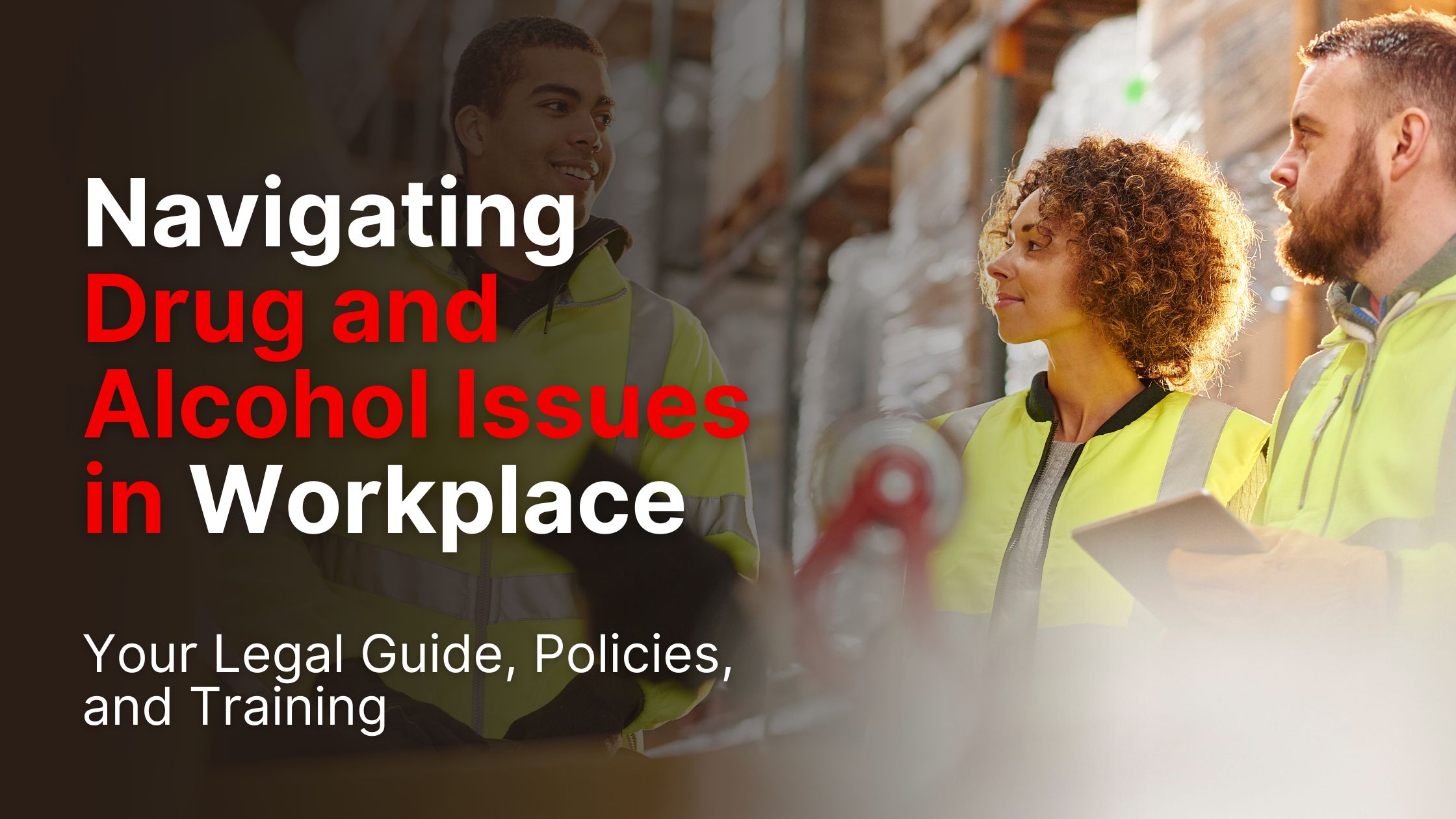Ensuring the effectiveness of Department of Transportation (DOT) drug and alcohol training programs is crucial for organizations in the transportation industry. Compliance is mandatory, but the quality and impact of these programs can vary widely.
How well employees understand and retain the information has a direct impact on safety, compliance, and overall organizational well-being. Therefore, evaluating the effectiveness of DOT training initiatives is essential for improvement and maintaining high standards.
This guide provides a structured approach to assess DOT drug and alcohol training effectiveness and offers practical tips on identifying areas of improvement.
10 Tips to Evaluate the Effectiveness of Drug and Alcohol Training
Drug and alcohol training is important for various reasons for transportation and logistics businesses. Here are some top strategies to evaluate the effectiveness of your training.
1. Establish Clear Goals and Objectives
Begin by defining clear, measurable goals for your training program. For DOT drug and alcohol training, objectives may include understanding policies, recognizing warning signs of substance use, understanding consequences of violations, and knowing where to seek help.
When your goals are specific, you have benchmarks that make it easier to measure effectiveness.
For example, a goal like “80% of employees should be able to recall key policy points without assistance” provides a quantifiable standard.
Key questions to consider:
- What knowledge or skills should employees gain?
- What behavioral changes should result from the training?
- What metrics will indicate success or areas for improvement?
2. Use Pre- and Post-Training Assessments
One of the most effective ways to gauge training effectiveness is by conducting assessments before and after training sessions.
Pre-training assessments help establish a baseline, revealing employees’ initial understanding of DOT drug and alcohol policies. Post-training assessments can demonstrate how much knowledge has been acquired or clarified.
Types of assessments to consider:
- Multiple-choice quizzes covering policy comprehension and procedures.
- Scenario-based questions to assess practical application of knowledge.
- Self-assessment surveys that help employees identify their own growth areas.
If employees score higher on post-training assessments, it suggests knowledge retention. However, if there’s minimal change, it may indicate a need to revise the training format or materials.
3. Monitor Real-World Application of Training
While assessment scores provide insight, they may not fully reflect how well employees apply training knowledge in the workplace.
Observing real-world behavior over time, such as supervisors’ responses to potential violations or drivers’ adherence to drug-testing protocols, can highlight the practical impact of your training.
Methods to evaluate application:
- Spot checks and audits to ensure employees are following DOT guidelines.
- Peer observation or supervisor feedback to assess behavior in specific situations.
- Incident reports before and after training to track any reductions in violations or infractions.
If supervisors and employees demonstrate correct application of policies, your training likely supports on-the-job safety and compliance. If behaviors do not improve, review the training content to ensure it emphasizes critical actions.
4. Evaluate Retention Rates Through Follow-Up Surveys
Knowledge retention fades over time, making follow-up surveys an essential part of long-term evaluation. Consider conducting surveys or quizzes one to three months after training.
These follow-up assessments allow you to evaluate whether the training's core principles remain clear in employees' minds.
Follow-up options:
- Surveys with open-ended questions to assess understanding of key topics.
- Periodic refresher quizzes to reinforce critical information.
- Self-reflection forms where employees can rate their confidence in handling drug and alcohol policy situations.
If survey responses indicate gaps in knowledge retention, periodic refreshers may be needed. Additionally, for complex topics or recent policy changes, interactive tools and visual aids may reinforce information effectively.
5. Gather Employee Feedback on Training Relevance and Engagement
Employee feedback is invaluable for understanding how engaging and relevant they found the training. Training sessions that are interactive, use real-life scenarios, or include multimedia elements typically receive more positive feedback than passive lectures.
Anonymous surveys are a practical way to collect this feedback without influencing responses.
Effective feedback tools:
- Anonymous surveys or questionnaires to gauge engagement and relevance.
- Post-training interviews to gather in-depth insights.
- Open feedback sessions where employees can share thoughts on the training format.
If employees found the training engaging and relevant, they’re more likely to retain the information and apply it on the job.
However, if feedback reveals that training was uninteresting or too general, consider customizing content, introducing interactive sessions, or including role-playing scenarios.
6. Analyze the Impact on Incident and Violation Rates
DOT drug and alcohol training is meant to reduce incidents and maintain compliance.
Monitoring incident and violation rates before and after training provides direct evidence of your program’s impact. Track metrics such as positive test rates, policy violations, and reported issues to determine if training has led to improvements.
Key indicators to track:
- Reduction in positive drug or alcohol test results over time.
- Decrease in reported policy violations by employees.
- Improvement in reporting of suspicious behavior or incidents.
If rates decrease, it’s a positive sign that training is effective. However, if rates remain steady or increase, conduct further investigation to pinpoint the root causes and consider updating the program to address specific issues.
7. Assess Supervisor Preparedness and Support
For DOT training programs, supervisors play a critical role in policy enforcement. Supervisors need to feel confident in both recognizing potential drug or alcohol issues and handling them according to DOT standards.
Evaluate supervisors’ preparedness by assessing their ability to address substance issues constructively and enforce policy compliance.
Supervisor-specific evaluation techniques:
- Role-playing scenarios to practice intervention in a controlled setting.
- Observation of supervisors handling incidents or issues.
- Feedback sessions with supervisors to discuss training applicability.
If supervisors feel prepared and confident, they’re more likely to enforce policies effectively. However, if feedback reveals hesitations, additional supervisor-specific training or resources may be necessary.
8. Review Training Program Structure and Content Regularly
Even effective training programs require periodic review to stay relevant and engaging. Regulations may change, or new methods for addressing substance abuse in the workplace may become available.
Reviewing your program’s structure ensures it aligns with the latest DOT requirements and industry best practices.
Considerations for regular review:
- Annual updates to reflect any new DOT policies or industry standards.
- Benchmark comparisons with other organizations’ training practices.
- Incorporating feedback from previous evaluations to improve training.
If reviews highlight outdated materials or misaligned content, consider adjustments that enhance relevance. Regularly refreshing content keeps the program current and provides employees with up-to-date information.
9. Determine Cost-Effectiveness of the Training Program
An often overlooked aspect of training evaluation is cost-effectiveness. Weigh the resources, time, and personnel needed for training against its benefits—such as fewer incidents, better compliance, and a safer workplace.
Reviewing cost-effectiveness helps you determine if your investment is yielding optimal results or if reallocations are needed for improvement.
Methods to measure cost-effectiveness:
- Cost per employee trained, relative to compliance and safety outcomes.
- Return on investment (ROI) based on changes in incident rates and fines avoided.
- Comparison with alternative training formats or delivery methods.
If your evaluation shows a favorable cost-benefit ratio, you can continue with confidence. Conversely, if costs outweigh benefits, it might be time to explore more budget-friendly or impactful training methods, such as online courses or group sessions.
10. Adjust and Improve Based on Evaluation Results
Finally, use evaluation results to make informed adjustments.
Incorporate insights from employee feedback, supervisor preparedness assessments, and compliance metrics to address weaknesses in your training program.
Continuous improvement is the key to an effective DOT drug and alcohol training program.
Improvement tips:
- Enhance areas of weakness based on assessment data.
- Experiment with new training formats, such as interactive modules.
- Introduce follow-up sessions or refresher courses.
Evaluating and improving your DOT drug and alcohol training initiatives not only ensures compliance but also creates a safer and more informed workplace.
Conclusion
There are several ways to evaluate the success of your DOT drug and alcohol training program, ranging from determining the impact and return on investment in the real world to comprehending knowledge retention and application.
You can make sure your training stays current, interesting, and useful by establishing clear goals, keeping an eye on results, getting feedback, and making adjustments on a regular basis.
This strategy protects your company's compliance, fosters a safer work environment, and eventually improves your team's ability to manage DOT-regulated duties efficiently.
Is your team ready to manage substance abuse issues effectively? With ICCouncil’s Drug and Alcohol Supervisor Training, you can create a safer, compliant workplace.






